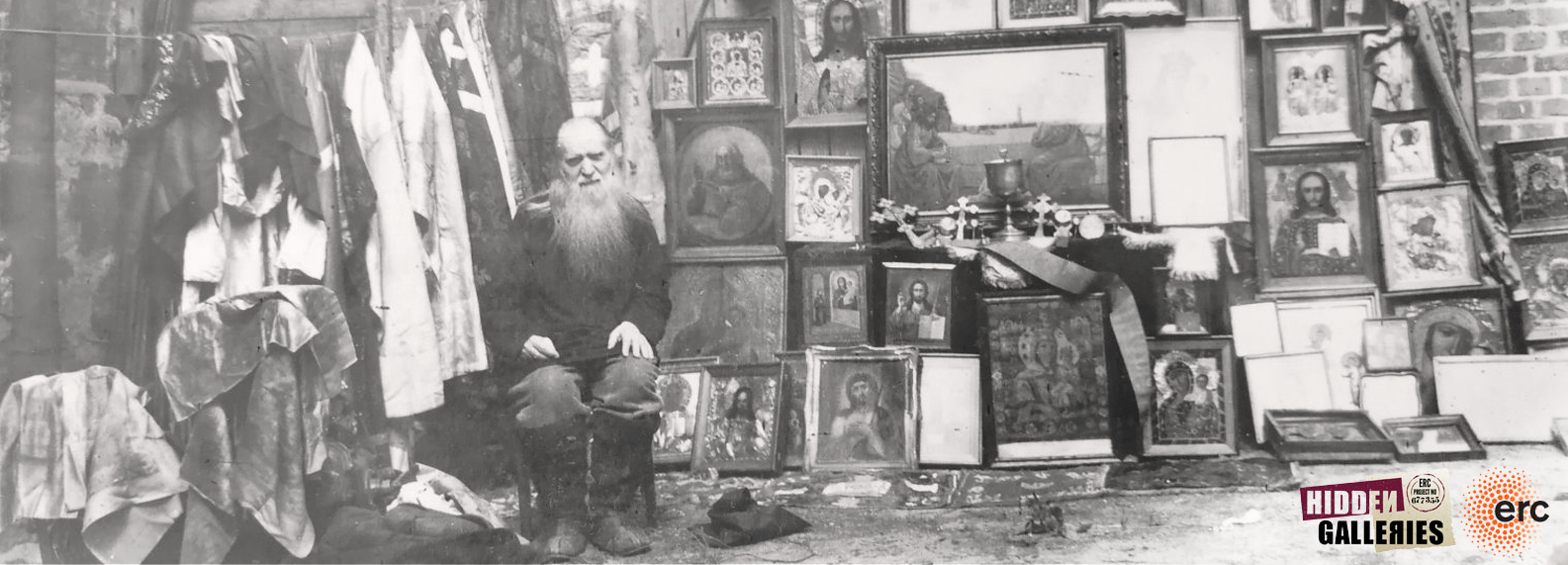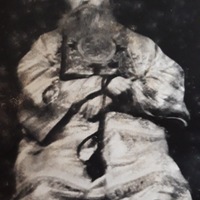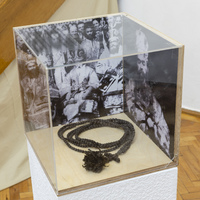Photograph of and religious object belonging to a dead spiritual leader of the Old Calendarist Romanian Orthodox Church
Item
Title
Photograph of and religious object belonging to a dead spiritual leader of the Old Calendarist Romanian Orthodox Church
Fotografii și obiect religios aparținând unui episcop defunct al Bisericii Ortodoxe Române de Stil Vechi
Description
The two photographs are related to the death of the Old Calendarist Romanian Orthodox Bishop Evloghie Oța and come as a result of extensive ethnographic fieldwork amongst Old Calendarist on-line communities and monasteries in Bucharest and Sibiu. The first picture represents Bishop Evloghie Oța before he was interred by his monastic brothers inside the underground church in Televiziunii street, 13 in February of 1979. From several descriptions given by informants of the Secret Police and in interviews with surviving witnesses, Bishop Evloghie Oța was interred sitting on the Bishop’s throne, dressed in episcopal vestments and holding the Holy Scripture and prayer beads. This picture, which is not found in Oța’s secret police file, fits perfectly the written description in the documents and the interviews with witnesses of the funeral. I first come across the picture in a Facebook group called Imagini de Arhivă ale Bisericii Ortodoxe de Stil Vechi (Archival images of the Old Calendarist Orthodox Church) where it was posted by Sebastian Hriscu who tagged the picture with a description "Pictured found in my grandmother’s archive". Further discussions revealed that the picture circulated amongst Old Calendarist communities throughout the country after the bishop’s death. I later acquired two other scanned copies of the same image from the monks at the Monastery of the Dormition of the Mother of God, Bucharest (Mănăstirea Adormirea Maicii Domnului a Bisericii Ortodoxe Române de Stil Vechi) where bishop Evloghie Oța was initially buried.
In 1983, the Secret Police, in an attempt to destroy the monastic community in Televiziunii street, arrested the monks. The body of the Bishop was exhumed and taken away. The church and the monastic complex have been tore-down, and the believers and monks were forbidden to return to the site. According to interviews with members of the church, the area was levelled and the land was used for agriculture until 1989. The whereabouts of the body of the bishop remain unknown.
The second picture represents a string of religious beads displayed in the Hidden Galleries project exhibition (Imagini din galerii secrete: religia clandestină în arhivele poliției secrete/ Rejtett galériák: Az üldözött vallásosság képei a titkosszolgálati levéltárakban) at the Art Museum in Cluj Napoca, Romania. The beads (metanii) belong to Bishop Flavian Bârgăoanu who, in an interview from April 2019 spoke about Bishop Oța beads that had been buried with him but were lost when the bishop was exhumed and his body and everything he was buried with were taken away by the Secret Police. He explained that a few months after the revolution when he and several monastic brothers returned to Televiziunii street he received a visit from a man that had helped with exhumation of bishop Oța's body. He brought with him the beads and told Bishop Flavian that they had been on the body of the bishop and that he had taken them away but so many bad things happened to him afterwards that he is now returning them to the monastery.
Bishop Flavian loaned the religious beads to be exhibited in Cluj for the duration of the exhibition.
Description of the burial of bishop Evloghie Oța and the details of his interment can be found in the CNSAS file I0161965 vol 1
In 1983, the Secret Police, in an attempt to destroy the monastic community in Televiziunii street, arrested the monks. The body of the Bishop was exhumed and taken away. The church and the monastic complex have been tore-down, and the believers and monks were forbidden to return to the site. According to interviews with members of the church, the area was levelled and the land was used for agriculture until 1989. The whereabouts of the body of the bishop remain unknown.
The second picture represents a string of religious beads displayed in the Hidden Galleries project exhibition (Imagini din galerii secrete: religia clandestină în arhivele poliției secrete/ Rejtett galériák: Az üldözött vallásosság képei a titkosszolgálati levéltárakban) at the Art Museum in Cluj Napoca, Romania. The beads (metanii) belong to Bishop Flavian Bârgăoanu who, in an interview from April 2019 spoke about Bishop Oța beads that had been buried with him but were lost when the bishop was exhumed and his body and everything he was buried with were taken away by the Secret Police. He explained that a few months after the revolution when he and several monastic brothers returned to Televiziunii street he received a visit from a man that had helped with exhumation of bishop Oța's body. He brought with him the beads and told Bishop Flavian that they had been on the body of the bishop and that he had taken them away but so many bad things happened to him afterwards that he is now returning them to the monastery.
Bishop Flavian loaned the religious beads to be exhibited in Cluj for the duration of the exhibition.
Description of the burial of bishop Evloghie Oța and the details of his interment can be found in the CNSAS file I0161965 vol 1
Cele două fotografii sunt legate de moartea episcopului ortodox român de stil vechi Evloghie Oța și sunt rezultatul unei ample lucrări de teren etnografice în comunitățile on-line și mănăstirile ortodoxe de stil vechi din București și Sibiu. Prima imagine îl reprezintă pe episcopul Evloghie Oța înainte de a fi înmormântat de frații săi monahi în interiorul bisericii clandestine din strada Televiziunii nr. 13, în februarie 1979. Din mai multe descrieri date de informatorii poliției secrete și în interviurile cu martorii supraviețuitori, episcopul Evloghie Oța a fost înmormântat așezat pe tronul episcopal, îmbrăcat în veșminte episcopale și ținând la piept Sfânta Scriptură și metaniile de rugăciune. Această imagine, care nu se regăsește în dosarul informative al lui Evloghie Oța alcătuit de poliția secretă, se potrivește perfect descrierii din documentele Securității și interviurile cu martorii înmormântării. Am întâlnit prima dată poza într-un grup de Facebook numit Imagini de arhivă ale Bisericii Ortodoxe de stil vechi, unde a fost postată de Sebastian Hrişcu care a etichetat poza cu o descriere „Fotografie găsită în arhiva bunicii mele”. Discuții ulterioare au arătat că imaginea a circulat printre comunitățile ortodoxe de stil vechi din toată țara după moartea episcopului. Ulterior am primit alte două copii scanate ale aceleiași imagini de la călugării de la Mănăstirea Adormirea Maicii Domnului a Bisericii Ortodoxe Române de stil vechi din București, unde a fost îngropat inițial episcopul Evloghie Oța.
În anul 1983, în încercarea de a distruge comunitatea monahală din strada Televiziunii, poliția secretă i-a arestat pe călugări. Trupul episcopului a fost exhumat și preluat de către administrația statului pentru a fi reînhumat ulterior. Biserica și complexul monahal au fost demolate, iar credincioșilor și călugărilor li s-a interzis să se întoarcă la locul respectiv. Potrivit interviurilor luate membrilor bisericii, zona a fost nivelată, iar terenul a fost folosit pentru agricultură până în 1989. Locația corpului episcopului rămâne necunoscută.
A doua imagine reprezintă un șir de metanii expuse în expoziția proiectului Hidden Galleries (Imagini din galerii secrete: religia clandestină în arhivele poliției secrete / Rejtett galériák: Az üldözött vallásosság képei a titkosszolgálati levéltárakban) de la Muzeul de Artă din Cluj Napoca, România. Metaniile aparțin episcopului Flavian Bârgăoanu care, într-un interviu din aprilie 2019, a vorbit despre metaniile episcopului Oța care fuseseră îngropate cu el, dar care s-au pierdut când episcopul a fost exhumat, iar trupul său și tot ce a fost îngropat cu el au fost luate de către poliția secretă. El a explicat că la câteva luni după evenimentele din 1989, când el și mai mulți frați monahi s-au întors pe strada Televiziunii, a primit vizita unui bărbat care a ajutat la exhumarea trupului episcopului Oța. A adus cu el metaniile și i-a spus episcopului Flavian că acestea s-au aflat pe trupul episcopului și că le-a luat, dar atât de multe lucruri rele i s-au întâmplat după aceea, că acum le întoarce la mănăstire.
Episcopul Flavian a împrumutat metaniile religioase pentru a fi expuse la Cluj pe durata expoziției.
Descrierea înmormântării episcopului Evloghie Oța și detaliile înmormântării sale se găsesc în dosarul CNSAS I0161965 vol. 1.
Subject
Communism--Romania
Communism--Romania--History--20th century
Communism and religion
Material culture--Religious aspects
Romania. Securitatea
Creator
Anca Sincan
Source
Consiliul Național pentru Studierea Arhivelor Securității (CNSAS)
I0161965, vol 1
I0161965, vol 1
Anca Sincan, Interview with Bishop Flavian Bârgăoanu, Monastery Adormirea Maicii Domnului, Televiziunii street, 13, Bucharest, April 15, 2019.
Publisher
This project has received funding from the European Research Council (ERC) under the European Union’s Horizon 2020 research and innovation programme No . 677355
Date
1979, 1983
Rights
Copyright for the image of Oța's dead body belongs to the Monastery Adormirea Maicii Domnului, Televiziunii street 13, Bucharest
Copyright of the image of the religious beads belongs to Hiddengalleries.eu
Format
jpeg
Language
RO
Type
image
Identifier
CNSAS
I0161965, vol 1
I0161965, vol 1
Coverage
20th century, Romania
Bibliographic Citation
Anca Sincan, Photograph of and religious object belonging to a dead spiritual leader of the Old Calendarist Romanian Orthodox Church
Date Created
2020


